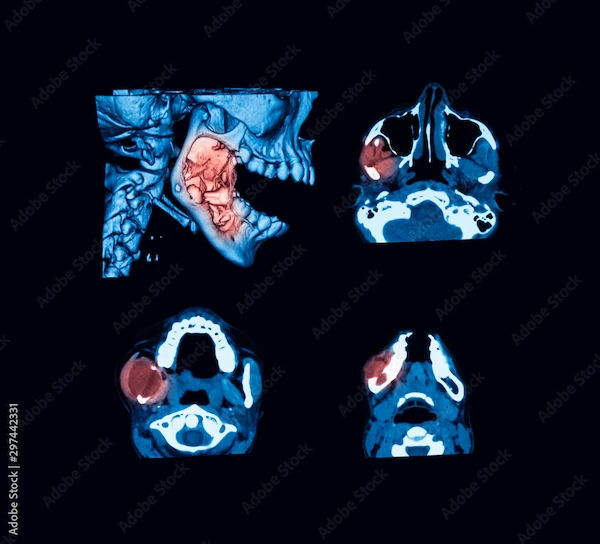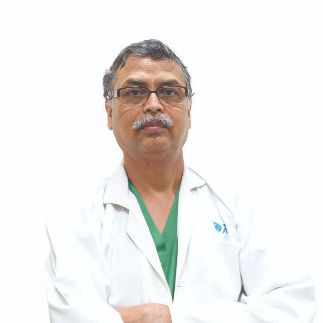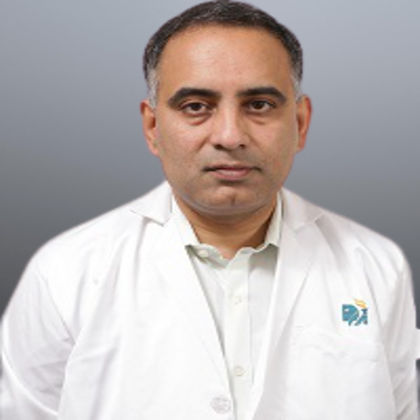All About Nasal and Paranasal Tumours: A Comprehensive Guide
Learn all about nasal and paranasal tumours, including types, symptoms, risk factors, diagnosis, treatment options, and prevention. Stay informed with expert insights.

Written by Dr.Sonia Bhatt
Last updated on 3rd Jul, 2025

Introduction
Nasal and paranasal tumours are abnormal growths that occur in the nasal cavity and the paranasal sinuses, the air-filled spaces around the nose. While some of these tumours are benign (noncancerous), others can be malignant (cancerous), posing severe health risks. This article aims to provide an in-depth understanding of nasal and paranasal tumours, covering their types, symptoms, diagnosis, treatment options, and preventive measures.
What Are Nasal and Paranasal Tumours?
The nasal cavity is the hollow space behind the nose that connects the nostrils to the throat. The paranasal sinuses are air-filled cavities located within the bones of the face and skull, connected to the nasal cavity. These structures play important roles in humidifying and filtering air, producing mucus, and resonating sound for speech.
A nasal tumour is a growth that forms inside the nasal cavity, while a paranasal tumour forms in one of the surrounding sinuses (such as the maxillary, frontal, ethmoid, or sphenoid sinuses). Tumours can develop on the soft tissue or bone of these areas, and they can range from benign to malignant.
Types of Nasal and Paranasal Tumours
There are several different types of tumours that can affect the nasal cavity and paranasal sinuses. These include:
1. Benign Tumours:
These are non-cancerous growths that do not spread to other parts of the body and usually grow slowly.
Nasal Polyps: These are soft, painless growths that develop on the lining of the nasal passages or sinuses. They are usually noncancerous but can cause significant discomfort, chronic congestion, and sinus infections.
Inverted Papilloma: A non-cancerous tumour that arises from the mucosal lining of the nasal cavity or sinuses. Though benign, inverted papillomas can cause significant issues, including bleeding or obstruction.
Hemangiomas: A benign tumour caused by an abnormal buildup of blood vessels in the nose.
Osteomas: Benign bone tumours that typically affect the paranasal sinuses. While often asymptomatic, they can grow large enough to cause obstruction or pain.
Angiofibromas: A rare benign tumour that mainly affects adolescent males, often found in the nasal cavity and paranasal sinuses. These tumours are vascular and can lead to heavy bleeding.
2. Malignant Tumours:
These are cancerous growths that can invade nearby tissues and spread to other parts of the body, often growing aggressively.
Squamous Cell Carcinoma: The most common type of nasal and paranasal sinus cancer arising from the lining of the nasal cavity or sinuses.
Adenocarcinoma: A cancer that originates in the glandular cells of the nasal cavity or sinuses.
Sinonasal Undifferentiated Carcinoma (SNUC): A rare and aggressive cancer that affects the nasal cavity and sinuses.
Esthesioneuroblastoma (Olfactory Neuroblastoma): A rare type of cancer that develops in the olfactory nerve, affecting the sense of smell.
Sarcoma: A rare cancer that develops in the connective tissues of the nasal and paranasal areas.
Symptoms of Nasal and Paranasal Tumours
The symptoms of nasal and paranasal tumours can vary depending on the type, size, and location of the tumour. Common signs and symptoms to look out for include:
Nasal Blockage: Difficulty breathing through one or both nostrils, especially on one side.
Chronic Nasal Congestion: Persistent stuffiness or blocked nasal passages that do not respond to typical cold treatments.
Nosebleeds: Recurrent or unexplained nosebleeds that may be severe or frequent.
Facial Pain or Pressure: This may include headaches, pain around the eyes, cheeks, or forehead, or a sensation of fullness or pressure in the face.
Loss of Smell: A decrease or complete loss of the sense of smell (anosmia).
Post-nasal Drip: Mucus draining down the back of the throat, which may cause coughing or a sore throat.
Vision Problems: In advanced cases, the tumour may press on the optic nerve, leading to blurry vision, double vision, or even loss of vision.
Swelling or Mass in the Face: Especially near the eyes or under the skin of the nose or cheeks.
Risk Factors for Nasal and Paranasal Tumours
The exact cause of nasal and paranasal tumours is not always clear, but several factors may increase the risk of developing these tumours:
Age: The risk of developing nasal and paranasal tumours increases with age, particularly in individuals over 50.
Gender: Some types of tumours, like juvenile nasopharyngeal angiofibroma, are more common in young males, while other cancers such as squamous cell carcinoma are more common in older males.
Exposure to Chemicals: Occupational exposure to substances like wood dust, formaldehyde, and other industrial chemicals may increase the risk of developing sinonasal cancers.
Tobacco Use: Smoking has been linked to an increased risk of squamous cell carcinoma in the nasal cavity and sinuses.
Human Papillomavirus (HPV): Certain strains of HPV have been associated with an increased risk of nasal and paranasal tumours, especially inverted papillomas and squamous cell carcinoma.
Chronic Inflammation or Infection: Conditions like chronic sinusitis, which causes prolonged inflammation in the sinuses, may increase the risk of developing tumours over time.
Diagnosing Nasal and Paranasal Tumours
If a nasal or paranasal tumour is suspected, a healthcare provider will perform a series of diagnostic tests to determine the nature and extent of the tumour. These may include:
Physical Examination: The doctor will look inside the nose using a tool called a nasal endoscope to visualise the nasal cavity and assess for abnormalities.
Imaging Tests:
CT Scan (Computed Tomography): Helps create detailed images of the nasal cavity and sinuses, showing the size and location of the tumour.
MRI (Magnetic Resonance Imaging): Provides a more detailed image of soft tissue and can help identify how the tumour is affecting surrounding structures.
Biopsy: A small sample of the tumour tissue may be taken for examination under a microscope. This is the definitive method to determine whether the tumour is benign or malignant.
Treatment of Nasal and Paranasal Tumours
The treatment of nasal and paranasal tumours depends on the type, size, location, and extent of the tumour, as well as the patient's overall health. Common treatment options for these tumours include:
Surgery: Surgical removal of the tumour is often the primary treatment. Depending on the size and location of the tumour, different surgical techniques may be used, including endoscopic surgery or open surgery.
Radiation Therapy: Radiation therapy uses high-energy beams to target and destroy cancerous cells. It may be used as a primary treatment or in combination with surgery.
Chemotherapy: Chemotherapy involves the use of drugs to kill cancer cells. It may be used for advanced nasal and paranasal tumours or when the cancer has spread to other parts of the body.
Targeted Therapy: Targeted therapy drugs specifically target cancer cells and inhibit their growth. This treatment may be used for certain types of nasal and paranasal tumours
Prevention of Nasal and Paranasal Tumours
Preventing nasal and paranasal tumours involves reducing risk factors and practising good health habits. Here are some key preventive measures:
Avoid Smoking: Quitting smoking can significantly reduce the risk of developing nasal and paranasal tumours.
Protective Measures at Work: Use protective equipment and follow safety guidelines to reduce exposure to harmful chemicals and irritants in the workplace.
HPV Vaccination: Getting vaccinated against HPV can reduce the risk of HPV-related cancers, including nasal and paranasal tumours.
Regular Check-Ups: Regular medical check-ups can help detect any early signs of nasal and paranasal tumours and other health issues.
Conclusion
Nasal and paranasal tumours, whether benign or malignant, pose significant health challenges. Recognising symptoms such as chronic nasal congestion, nosebleeds, facial pain, and loss of smell is vital for timely diagnosis and treatment. Treatment options, including surgery, radiation therapy, and chemotherapy, vary based on the tumour type and severity. Preventative strategies, such as avoiding exposure to carcinogens, maintaining proper nasal hygiene, and adopting a healthy lifestyle, are beneficial in reducing tumour risk. If you or someone you know experiences persistent nasal or sinus symptoms, seeking prompt medical evaluation is crucial for early detection and effective management.
Consult Top Oncologists
Consult Top Oncologists

Dr. Tarun Jindal
Uro Oncologist
14 Years • MS (AIIMS, New Delhi), MCh (Gold Medalist), Fellow, VUI, Henry Ford Hospital, Detroit, USA; Robotic and Laparoscopic surgeon
Kolkata
Apollo Multispeciality Hospitals , Kolkata, Kolkata
(100+ Patients)

Dr. Sandeep Muzumder
Radiation Specialist Oncologist
21 Years • MBBS (JIPMER, Pondicherry), MD (AIIMS, New Delhi)
Bhubaneswar
Apollo Hospitals Old Sainik School Road, Bhubaneswar

Dr. Ganesh Chandra Subudhi
Medical Oncologist
16 Years • MBBS, MD- General Medicine. DrNB- Medical Oncology (DNSH, Delhi ). Consultant - Medical Oncology at Apollo Cancer Centre, Bhubaneshwar.
Bhubaneswar
Apollo Hospitals Old Sainik School Road, Bhubaneswar

Dr. Praveen Kumar Garg
Surgical Oncologist
26 Years • MBBS, M.S.(Gen.Surg.), M.Ch.(OncoSurg.)
Delhi
Apollo Hospitals Indraprastha, Delhi
(25+ Patients)

Dr. Raja T
Oncologist
20 Years • MBBS; MD; DM
Chennai
Apollo Hospitals Greams Road, Chennai
(150+ Patients)